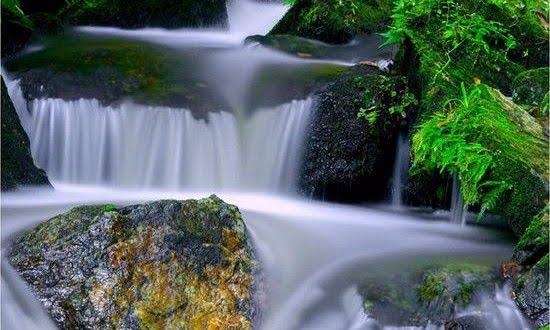GENERAL OVERVIEW
Olumirin Waterfalls, popularly called Erin-Ijesha Waterfalls is a multi-tiered waterfall in Erin-Ijesha (sometimes written Erin-Ijesa), Oriade Local Government Area, Osun State, southwestern Nigeria. The falls sit on a high cliff on the southern slope of the Effon-Alaye/Erin hills; the climb starts in Osun State and reaches a top village (Abake) near the Osun–Ekiti border. The site is roughly a short drive east of Ilesa and a few hours by road from Ibadan or Lagos.
UNIQUENESS
Seven distinct cascades (seven levels)—Olumirin is famous for its seven successive drops/levels, each level forms its own pool and micro-landscape. Climbers commonly ascend from the base to the uppermost cascade, experiencing different views and pools at each stage. That multi-tiered structure is the waterfall’s signature and the main reason it’s so photogenic and popular with hikers.
Culturaldepth—Local tradition traces discovery of the falls to Akinla (a granddaughter of Oduduwa) or to early hunters, and the name Olumirin is said to imply “another god”, a hint at its spiritual/cultural importance to the Ijesa people. Ritual and festival use historically accompany the site.
CULTURAL AND ECOLOGICAL SIGNIFICANCE
Sacredand historical—For generations, local people have regarded the falls as sacred, using the waters in purification rites and rituals; the waterfall is woven into origin stories of Erin-Ijesha town.
Biodiversity& ecosystem services—The falls are embedded in a forested, rocky landscape that supports local flora and fauna, helps recharge local springs and groundwater, and moderates micro-climates for surrounding farms and settlements. Recent scientific work has also focused on water quality and environmental monitoring because of its ecological importance and tourism use.
TOURIST PONTIALITIES
Hiking& adventure—The ascent across seven levels is a major draw. Some visitors treat it like a full-day hike, the higher levels are quieter and more scenic.
Swimming & picnic—Several of the lower pools are suitable for cooling off; the base pools are popular for family trips and school excursions.
Photography & nature study—Dramatic rock faces, plunging water, and lush surrounds make it great for landscape photography, birding, and small-scale field studies.
Community tourism—Proximity to Erin-Ijesha town makes it ideal for short cultural tours; local food, handicrafts, and interaction with host communities add value and glamour to the environment.
STRENGTHS
Iconic natural beauty—The seven cascades are visually striking and memorable; a natural asset that already attracts domestic and international visitors.
Accessiblefrom major towns—Reasonable road access from Ilesa and Ibadan (and onward from Lagos) makes it feasible as a weekend destination.
Higheducational & research value—The site is suitable for environmental, geological and cultural research; recent water-quality studies show academic interest.
PERSONALITIES AND ACTORS CONNECTED TO THE SITE
Akinla / Oduduwa lineage—In local historical accounts, Akinla (a descendant of Oduduwa) is associated with the discovery/founding myths of Erin-Ijesha and naming of Olumirin. This is a cultural/personality reference rather than a modern celebrity.
Localmonarchs and community leaders—Chiefs and the traditional ruler of the community have historically played roles in managing the site and advocating for investment; there have been public statements about local management and potential private partnerships.
Governmentactors—In 2024 the Osun State government publicly directed the upgrading and a tripartite committee to improve the falls after media attention about its condition, showing political interest in restoration and tourism development.
CHALLENGESAND THREATS
Neglect and poor maintenance—Multiple reports and eyewitness accounts in recent times have described littering, erosion, and inadequate maintenance formed the major problems that reduce visitor’s ecological experience of the site.
Pollution& water quality risks—Studies and media coverage have raised concerns about pollution (solid waste) and potential contamination of waterways near tourist flows and nearby human activities. Ongoing monitoring and remediation are needed.
Inadequate Infrastructure & safety—Facilities such as safe walkways, signage, secure parking, sanitation, and trained guides are limited or inconsistent; lack of formal security has also been highlighted. These gaps limit higher-value tourism and can endanger visitors.
Funding & management model—Effective, sustainable tourism requires clear management, investment and benefit-sharing with host communities. Debates have occurred about whether government, private investors, or community trusts should lead development.
TIPS FOR VISITORS
Best time to go—Dry season visits are easier for hiking and access; after heavy rains the paths can be slippery and some pools stronger. (Local weather and road conditions should be checked in advance.)
What to bring—Good walking shoes, water, light rainproofs, sunscreen, a small first-aid kit, and trash bags (carry out what you bring in). Respect local customs; parts of the falls are considered sacred.
Guides & safety—Hire a local guide where available who know safe routes between levels, cultural protocols, and can support emergency response if needed.
OPPORTUNITIES & RECOMMENDATIONS (short-term & long-term)
1. Immediate site remediation—Community clean-ups, waste bins, basic toilets, and clear signage to improve visitor experience and stop littering. (There has been government commitment to upgrades.)
2. Safety & trail improvements—Construct safe steps and handrails in risky sections, create marked trails to each level, and train local guides in first aid.
3. Community-based tourism & revenue sharing—Involve host communities in gatekeeping, guided tours, food stalls and craft sales so tourism benefits locals and motivates stewardship. Research shows locals want development tied to infrastructure and jobs.
4. Environmental monitoring and visitor limits—Continue water-quality studies, set simple visitor carrying-capacity rules during sensitive seasons, and design educational signage about conservation.
5. Marketing & integrated routes—Package Olumirin with other Osun cultural sites (e.g., Osun-Osogbo, local festivals) to attract longer stays and higher tourism spend.
FINALLY
Olumirin (Erin-Ijesha) Waterfalls is one of Nigeria’s most evocative natural attractions—dramatic seven-tiered cascades, cultural depth, and strong local identity. With focused investment in basic infrastructure, conservation and community-led tourism, the site could deliver greater economic, educational and ecological returns while preserving the very features that make it special. Recent government statements and academic interest suggest momentum for improvements; the critical next step is turning plans into sustainable, community-centred action.




